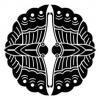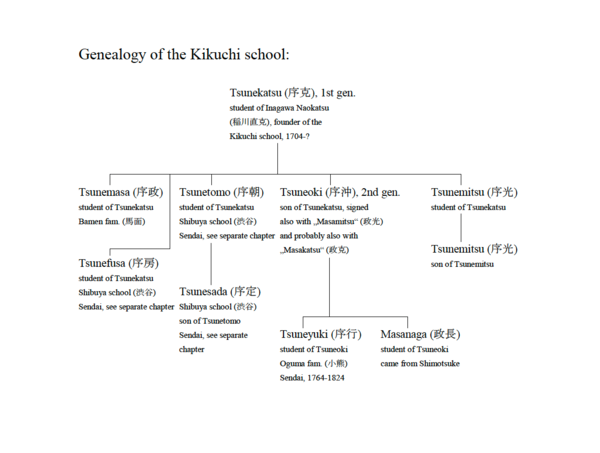-
Posts
610 -
Joined
-
Last visited
-
Days Won
3
Content Type
Profiles
Forums
Events
Store
Downloads
Gallery
Everything posted by kyushukairu
-
Jake, firstly, Akita and Shonai are two separate regions. The founder of the Akita-Shoami school (Denbei) was born in Shonai, and his older brother (Kiyonari) who he learned a lot from, was a master of the Shonai-Shoami school. My point was that Denbei, who was originally from Shonai (but later moved to Akita) trained in the style of Shonai-Shoami. So even though he later developed his own style, we also see works in the Shonai style by him, and the picture I posted is one such example. I know it has become fashionable to question NBTHK attributions as they are often generic and occasionally make mistakes, but the people who do these have seriously studied swords and fittings for a significant proportion of their lives. Perhaps you want it to be a Higo tsuba because such an attribution seems more appealing than Shonai, but it seems as though you are overly fixating on the 'Hosokawa' kamon. There are also four other kamon on that tsuba which you are not taking into consideration. Do these have any connection to Hosokawa? Moreover, the fukurin on the Hirata Hikozo is completely different to your tsuba and the Denbei example (as is the shape), and is not comparable at all. Odawara fukurin are a kantei point for Hirata Hikozo. Of the two tsuba Dale listed, only one has papers (to Nishigaki). The one on Grey's website, doesn't have a fukurin and has a very different aesthetic (it's much chunkier). I think Curran's insights (a, b, and c) explain the difference in attributions between the papered Nishigaki and yours very well. Also, look at the tagane around the nakago-ana on your tsuba, the * shaped tagane was not used by any Higo master (that I am aware of). Also, Curran knows the Higo schools very well, so if he disagrees that it is Higo, I think that it's right to accept the NBTHK's attribution of 'Shonai'.
-
Shonai. There's a similar tsuba (in terms of shape, material, and fukurin) by Akita Shoami Denbei, who was originally from Shonai
-
Many thanks, Arnaud. I had a look at Kawami-san's paper and read the quotation on the first page. However, the discussion only mentions the cost of swords. Valignano says that in Japan a single sword may cost 3000, 4000, and even 6000 ducats. He then says that Ōtomo Sōrin showed him a sword which cost 4500 ducats, and Valignano then states that he thinks this is a ridiculous amount of money because there is no material value, which he empathizes by saying the tsuba was made of iron, not gold. 「なぜなら一本の刀 を、三千、四千、あるいは六千ドゥカードも出して購う。私はそれらの高価なものの幾つかを見たが、 その中には豊後国王(大友宗麟)が私に見せたものがある。彼はそれを四千五百ドゥカードで購入し たのであるが、その鍔は黄金ではなく、単なる鉄製に過ぎなかった。私はそれらの高価なものの幾つかを見たが、 その中には豊後国王(大友宗麟)が私に見せたものがある。彼はそれを四千五百ドゥカードで購入し たのであるが、その鍔は黄金ではなく、単なる鉄製に過ぎなかった。」
-
Arnaud, do you have a source for this? As someone who previously lived in Oita (Bungo) and is interested in Bungo/ Otomo related tosogu, I'd like to look into this further
-
Dear all, In the wanted section I had listed that I'm looking for 'Akita Shoami tsuba' and received a message from a 'member' with 0 posts. The message was quite generic, reading 'are you still looking for this' and 'contact Garnie he has a Akita Shoami tsuba for sale'. There was also an email address to contact 'Garnie', which was probably newly created too. If anyone else has received/ receives such an email, I advise you to ignore it. Stay vigilant, there are lots of scammers around this time of year Yours authentically, Kyle
-
Hello Bruno. If you interpret the small protruding circular shapes on either side as cheeks and at the bottom as a chin, then I can see the resemblance to Okame/ Otafuku, but the design may simply be a kamon with three repeated images. In that case, it would probably be classified as 'kawari-gata' (変わり形), which is used for unusual shaped tsuba.
-
Mario is also right, 藻柄子 can be read as Sōheishi too
-
In my opinion, the shakudo plugs were part of the original design. As for the theme, I think the sukashi (and shakudo plugs) are intended to represent a flowering plant or vegetable - perhaps daikon (Japanese raddish), which is a symbol of fertility and longevity. When mounted on a sword, and being worn in an obi, one would observe the flowering leaves flowing above and around the tsuka. And when matched with a (fuchi)kashira of complimentary theme (of a daikon or something similar), the image would become quite prominent. The Umetada school excelled at such floral motifs (though done in flush inlay of various metals) (Image taken from https://japaneseswordbooksandtsuba.com/store/tsuba-kodogu-over-1000/t159-shakudo-umetada-tsuba-gold-silver-copper-zogan/)
-
Front/ omote Mogarashi (藻柄氏) Nyūdō Sōten sei (入道宗典製) Back/ ura Gōshū (江州) Hikone jū (彦根住)
-
11th year of Bunsei (1828) Umetada Sanshoshi Narihide made this [文政十一年梅忠三省子就栄作之] (三省子 can also be read as Sanseishi) Okusenda Katsuyuki jū (奥仙田勝之住) Unyū (雲遊)
-
Dear Jake, it's a nice set of fuchigashira and not out of line with what one would expect from the Hamano school. However, I don't think this set would paper to Shozui. Although the quality is good, I don't think it's good enough for Shozui, who was considered to be on par with the top Nara masters. There are also quite a few inconsistencies in terms of the mei. The top left hand stroke of 正 in 政, for example, floats higher than all of the examples in the meikan, and the third stroke is too long. In the second part of that kanji (攵) the third stroke isn't usually connected to the first two strokes. In general, that kanji lacks the balance seen in all shoshin (papered) examples that I've seen. Sorry to be the bearer of bad news... It is a nice set though, and the glass eye is an interesting feature. In general, I'd avoid buying big names without papers from Japan. It is possible to find some treasures, but artists like Shozui (and Yokoya Somin, of whom there are also lots gimei examples) will sell for a considerable amount of money with papers, and in Japan it is fairly easy to submit for kanteisho. So if someone knows what they have there is the financial incentive to submit for papers and make a lot of money.
-
The wakizashi is signed 'Fujiwara Noriyuki' (藤原則行), most likely a mid-Edo, Bungo smith.
-
A fairly pleasing design. It would most likely be attributed to a swordsmith (tōshō 刀匠) or possibly even 'Umetada' (埋忠), [Umetada Tadatsugu (埋忠忠次) did such sukashi work]
-
You're very welcome, Brano! Jean, I'd wager no 13 is indeed san-mai. Brano, if you look in the nakago-ana is there a copper core sandwiched between two shakudo plates?
-
Hello Steve. Just a quick comment (before I go to give a lecture), in the book, the tsuba is described as 笠透かし, with kasa (笠) meaning a type of bamboo hat, so that may be the design, rather than namako
-

Help with holster translation - thanks
kyushukairu replied to Nolacat's topic in Translation Assistance
Unfortunately, these are just inspection marks. If you orientate the image to the right you can see them better: ア二三?昭⚪︎ This translates to A23? followed by the Sho(wa) stamp, and the arsenal stamp, which I think may be Nagoya Army Arsenal (Nagoya Rikugun Zoheisho)- 1 reply
-
- 2
-

-
Some info on the schools 1 - Mino (later gen) 2 - Shingen 3 - Shingen 4 - Shingen 5 - Heianjo 6 - Heianjo 7 - Tempo/ Heianjo 8 - Signed ‘Masanori’ (正矩作) likely Bushu 9 - Mito 10 - Aizu-Shoami 11 - Bushu 12 - Signed 'Choshu Hagi ju Nakai Zensuke/ Tomotsune' (長州萩住中井善助/友恒) 13 - Ko-kinko
-

Information on the Kikuchi School or Kikuchi Jyosui
kyushukairu replied to Jake6500's topic in Tosogu
Here's the Kikuchi School's genealogy for future reference. Also from Sesko’s Signatures of Japanese Sword Fitting Artists pg.25. -

Information on the Kikuchi School or Kikuchi Jyosui
kyushukairu replied to Jake6500's topic in Tosogu
Jake, I don’t think the first tsuba which you posted (from Aoi Art) is linked to the Kikuchi school, there is no artist listed with that name, and the style isn’t in keeping with the Kikuchi school, who specialised in katakiribori. In my opinion, it’s a Mito school tsuba with a fictitious mei. The second tsuba which you posted is by Kikuchi Tsunekatsu, the founder of the Kikuchi school. I had a quick look at the meikan and the kao looks good to me. Here’s some information about him from Sesko’s Signatures of Japanese Sword Fitting Artists: 24.1 Kikuchi Tsunekatsu (菊池序克), 1st gen. The founder of the Kikuchi school was Tsunekatsu, a student of Inagawa Naokatsu (稲川直克). He also received the character for „Katsu“ from the latter. He was born in the first year of Hōei (1704) and was called „Seijirō“ (清次郎). Because of his artistic background in the Inagawa school he worked mostly in shakudō with nanako ground and takabori-iroe ornamentations but his strong point was katakiribori. In his later years he entered priesthood and took the nyūdō-gō „Sōju“ (宗寿). Other pseudonyms of Tsunekatsu were „Sōryūken“ (草流軒) and „Gidōken“ (蟻洞軒). There are also works extant which are signed with the characters (常克) for „Tsunekatsu“ and it is assumed that they go back to his earlier years. In addition, we know a joint work (gassaku, 合作) with Naoharu (柳川直春, 1750-?), the 3rd gen. Yanagawa, which is signed with the supplement „made at the age of 60“. That means Tsunekatsu was also in direct contact with the Yanagawa school. His year of death is unknown but the latest extant information about his age mentions „made at the age of 64“. That means he was at least active until the Meiwa (1764-1772) era. -

Skulls, bones, and grave markers—An interesting tsuba
kyushukairu replied to brentlewiis's topic in Tosogu
As Steve notes, on the left of the nakago-ana is 'Kikuchi Masahira' (菊地正平), but on the right is 'Bungo jū' (豊後住). There was only one professional tsubako in Bungo - Yasaka Eikan (八坂永閑). However, as with a lot of Satsuma tosogu, some Bungo swordsmiths also made fittings. I believe this to be the case with your tsuba. The most likely candidate is "MASAHIRA (正平), Kyōhō (享保, 1716-1736), Bungo → MASAHIRA (政平), Kyōhō (享保, 1716-1736), Buzen" -
Could be 'Harushige' (春重)
-
I agree with Ron. The kanji on the left look like 'Bushū jū' (武刕住) The second character on the right may be '~shige' (?重)
-

old news paper cutting of a sword shop
kyushukairu replied to lonely panet's topic in Translation Assistance
Although the logo at the bottom (and the entire advert) seems to be for Nihombashi Takashimaya (日本橋高島屋), which still exists today (https://www.takashimaya.co.jp/nihombashi/). Nihombashi Takashimaya is a department store. The sword advert refers to an Exhibition and Sale of Art Swords (美術刀剣展示即売会) which took place in that department store on Sunday (日) 3rd of June (6月3日). Unfortunately, it doesn't list the year in the advert. However, I had a quick search and it seems that the 3rd of June was a Sunday in 1989, so this may be the year of the newspaper, when the event took place, and when your tsuba was offered for sale. -









